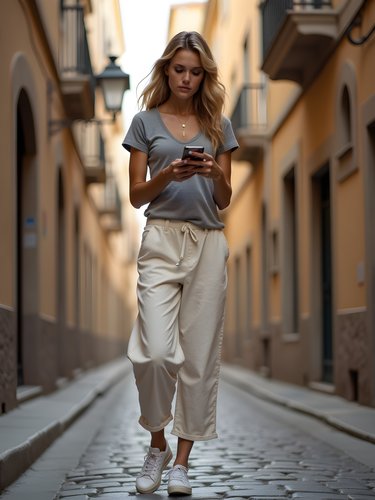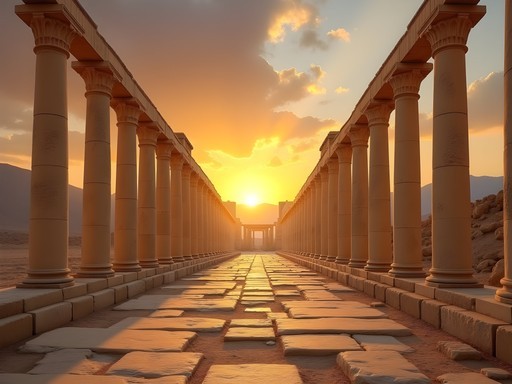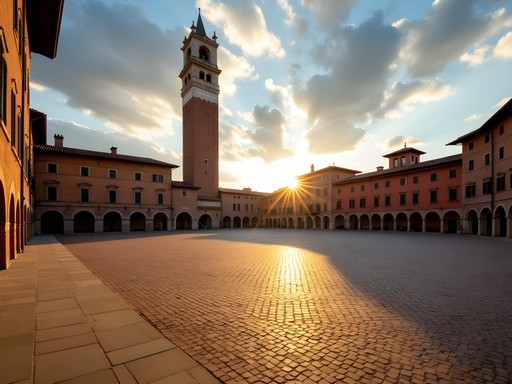Disclosure: This article contains affiliate links. We may earn a commission from purchases at no extra cost to you, which helps our travel content.
Standing before the Temple of Bel—or rather, what remains of it—I'm struck by the profound silence that blankets Palmyra's ancient stones. The golden hour light casts long shadows across columns that have witnessed over two millennia of human history, trade, conflict, and resilience. This isn't my typical family travel post, nor is it a standard destination guide. My week in Palmyra was perhaps the most challenging yet intellectually rewarding journey I've undertaken since leaving my finance career behind. As someone who's photographed architectural wonders across 42 countries, I can tell you that nothing prepares you for witnessing firsthand a UNESCO World Heritage site that has survived both the natural erosion of time and the deliberate destruction of war. This post explores how to approach Palmyra responsibly, with cultural context at the forefront and practical considerations for the intrepid solo traveler willing to venture into a region still healing from conflict.
Understanding Palmyra's Historical Significance
Palmyra isn't just another archaeological site—it's a testament to cultural crossroads that once connected the Roman Empire to Persia, creating a unique Greco-Roman-Persian architectural language that existed nowhere else. Before planning my visit, I spent months researching with my comprehensive guide, which provided crucial historical context beyond what standard travel guides offer.
Founded in the 3rd millennium BCE, Palmyra (known locally as Tadmur) flourished as a vital caravan city along the Silk Road. What makes these ruins extraordinary is how they represent a perfect fusion of Eastern and Western architectural traditions—Roman columns stand alongside distinctly Persian motifs, creating a visual language that speaks to Syria's historical role as a cultural bridge.
The city reached its zenith under Queen Zenobia's rule in the 3rd century CE, when she famously challenged Rome itself before ultimately being defeated. Walking through the colonnade that forms the city's main thoroughfare, I traced my fingers along stone that has witnessed empires rise and fall, wondering how many travelers before me had sheltered in the shade of these same columns.
What struck me most was how Palmyra's architecture reflects its cosmopolitan nature—temples dedicated to Mesopotamian, Arabian, and Greco-Roman deities all coexisted, showcasing an ancient pluralism that feels particularly poignant given the region's recent history.

💡 Pro Tips
- Read about Palmyra's history before visiting—context transforms ruins into stories
- Download offline maps and historical reconstructions to understand how the city once looked
- Visit early morning or late afternoon for the best photography light and fewer visitors
Navigating the Complexities of Post-Conflict Tourism
Let me be transparent: visiting Palmyra requires careful ethical consideration. After ISIS occupation damaged significant portions of the site between 2015-2017, including the heartbreaking destruction of the Temple of Bel and the iconic Lion of Al-lāt statue, traveling here means confronting difficult questions about cultural heritage in conflict zones.
I deliberated for months before deciding to visit. What ultimately convinced me was conversations with Syrian archaeologists and heritage experts who emphasized that responsible tourism can support conservation efforts and local communities devastated by conflict.
Security situations change rapidly, so I worked with specialized tour operators who maintain current safety protocols and employ local guides. My guide Hassan, a Palmyra native and archaeology graduate, offered insights no guidebook could provide—including how his family protected artifacts during the occupation by hiding them in their home.
Prepare for extensive security checkpoints and documentation requirements. I carried multiple copies of my permits and traveled with a document organizer that kept everything accessible yet secure against my body.
The emotional impact shouldn't be underestimated. Seeing the reconstructed Lion of Al-lāt statue (the original was destroyed in 2015) brought me to tears—not just for what was lost, but for the determination of Syrians working to preserve and restore their heritage. This isn't dark tourism; it's bearing witness to both human destruction and the resilience that follows.

💡 Pro Tips
- Work only with tour operators specializing in post-conflict regions who prioritize local employment
- Prepare all documentation meticulously and keep digital backups
- Research the ethics of your visit and how your tourism dollars will impact communities
Architectural Highlights Beyond the Headlines
While media coverage has understandably focused on Palmyra's damaged monuments, much of the ancient city remains intact and awe-inspiring. The Great Colonnade stretching over a kilometer still gives visitors a sense of Palmyra's urban grandeur. I spent hours photographing the subtle details—the Corinthian capitals with their distinctive Palmyrene modifications, the inscriptions in both Greek and Aramaic that speak to the city's multilingual past.
The Theater, though partially damaged, remains an architectural marvel. Sitting on its ancient stone seats at sunrise, I sketched the scene in my travel journal, imagining the performances that once took place here. My compact binoculars proved invaluable for observing architectural details on distant structures without needing to climb fragile ruins.
Perhaps most moving was the Valley of Tombs with its tower-shaped funerary monuments. Unlike the public monuments that often bear the brunt of ideological destruction, many of these family tombs survived with their intricate relief sculptures intact. These carvings offer intimate glimpses into Palmyrene society—women wearing distinctive turbans and heavy jewelry, men in Persian-influenced garments, families dining together in funerary banquet scenes.
The Palmyra Archaeological Museum has been partially reopened, housing artifacts rescued before and during the conflict. The dedication of the museum staff, who risked their lives to evacuate thousands of artifacts to Damascus for safekeeping, demonstrates the profound connection Syrians feel to their cultural heritage.

💡 Pro Tips
- Bring a sketchbook to document details—drawing forces you to observe architecture more closely than photography
- Visit the museum first to understand the context before exploring the ruins
- Ask permission before photographing local restoration workers
Accommodation and Logistics: The Realities of Frontier Travel
Let's address the practical challenges: traveling to Palmyra requires significantly more preparation than your typical Mediterranean getaway. Currently, most visitors base themselves in Damascus and arrange day trips or overnight excursions through specialized agencies with appropriate security clearances.
During my visit, I stayed at a small guesthouse on the outskirts of modern Tadmur city operated by a family who returned after the conflict. The accommodations were basic but clean, with home-cooked meals that became a highlight of my trip. Expect intermittent electricity and limited internet access—I relied heavily on my solar power bank to keep essential devices running.
Water is precious in this desert region, so prepare for limited showering facilities. I brought biodegradable wet wipes and dry shampoo to stay refreshed between proper showers. Pack modest clothing regardless of the season—not only for cultural sensitivity but also for protection from the intense desert sun.
Permits are non-negotiable and must be arranged well in advance through authorized agencies. The paperwork process can be frustrating and opaque, but patience is essential. Build flexibility into your itinerary, as access to certain areas can change based on ongoing restoration work or security considerations.
Mobile coverage is spotty, and I found my international roaming service rarely connected. Instead, I purchased a local SIM card in Damascus before departing for Palmyra. Most importantly, bring sufficient cash (preferably in small denominations of USD or Euros)—there are no functioning ATMs, and credit cards are not accepted anywhere in the region.

💡 Pro Tips
- Pack a comprehensive first-aid kit including prescription medications—medical facilities are extremely limited
- Download offline maps, translation apps, and any reference materials before leaving Damascus
- Bring thoughtful gifts for hosts—quality tea or coffee from your home country is always appreciated
Engaging Respectfully with Local Communities
The most profound aspect of visiting Palmyra isn't the stones themselves, but connecting with the people for whom these ruins aren't just history—they're home. Modern Tadmur has existed alongside the ancient city for centuries, and many residents trace their ancestry to the region for generations.
Many local families have returned after being displaced during the conflict, rebuilding their lives and livelihoods amid tremendous challenges. Tourism, when conducted responsibly, provides crucial economic opportunities. I made a point to purchase items directly from artisans rather than souvenir shops, including a beautiful hand-carved limestone replica of a Palmyrene relief made by Hassan's father, who learned traditional stone carving techniques from his grandfather.
Language barriers exist, but simple Arabic phrases go a long way. I used a pocket phrasebook daily, and the resulting smiles were worth the effort of my clumsy pronunciation. Sharing photos of my family back in Valencia created immediate connections with local families who were curious about my life as much as I was about theirs.
Perhaps most important is approaching conversations with sensitivity. Many residents have experienced profound trauma and loss during the conflict. Follow their lead on topics of conversation, and never pressure anyone to discuss political matters or personal experiences of war. Instead, ask about local traditions, cuisine, or family celebrations.
I was invited to share a meal with Hassan's family on my final evening—a feast of makdous (stuffed eggplant), kibbeh, and fresh flatbread that put every restaurant meal I'd had in Damascus to shame. As we sipped mint tea under a star-filled desert sky, the ancient columns silhouetted against the night, the artificial boundaries between visitor and host, ancient and modern, momentarily dissolved.

💡 Pro Tips
- Learn basic Arabic greetings and thank-you phrases—even imperfect attempts are deeply appreciated
- Ask permission before photographing local people, especially women and children
- Support local economies by hiring local guides and purchasing directly from artisans
Final Thoughts
As I left Palmyra, watching the ancient columns recede in my rearview mirror, I reflected on how sites like this challenge us as travelers. They demand we move beyond the superficial, beyond the perfect Instagram shot, to engage with difficult questions about heritage, conflict, and resilience. Palmyra isn't just a destination—it's a responsibility. By visiting thoughtfully, supporting local communities, and sharing nuanced stories that go beyond headlines, we participate in preserving cultural heritage not as static ruins but as living connections between past and present. If you choose to follow in these footsteps, do so with humility, preparation, and an openness to having your perspectives transformed. The desert city has weathered millennia of triumph and tragedy—what it offers the mindful traveler isn't just a glimpse of the past, but a profound lesson in human endurance.
✨ Key Takeaways
- Cultural heritage sites in conflict zones require special ethical consideration and extensive preparation
- Supporting local communities through responsible tourism can contribute to cultural preservation
- Historical context transforms ruins from mere stones to meaningful stories
- The resilience of local communities in preserving their heritage despite tremendous challenges is the most inspiring aspect of visiting Palmyra
📋 Practical Information
Best Time to Visit
March-May or September-November
Budget Estimate
$150-200 per day including specialized guides and permits
Recommended Duration
3-4 days minimum
Difficulty Level
Challenging
















Comments
skyvibes
I visited Syria back in 2009, before everything happened. Palmyra was magical then - bustling with tourists and researchers. Your post brought tears to my eyes seeing how much has changed. I still have my little notebook where I sketched some of the carvings at the Temple of Bel. Thank you for showing how important it is to document these places, even in their damaged state. History needs witnesses.
Claire Hawkins
Thank you for sharing that. It must be especially poignant to have seen it before. The local guides I spoke with shared pre-conflict photos and the difference is stark. But there's also something powerful about seeing the resilience of both the structures and the people who protect them.
skyvibes
Absolutely. Would you mind if I emailed you? I'd love to hear more about the restoration efforts you mentioned.
adventurediver
How did you handle accommodation? I imagine there aren't many hotels operating nearby?
luckyclimber
That golden hour shot of the colonnade is absolutely breathtaking! Did you have the place mostly to yourself?
Claire Hawkins
Yes, there were only about 8-10 other visitors while I was there. It was hauntingly quiet compared to how it must have been before the conflict.
Sarah Powell
Claire, thank you for this thoughtful piece on Palmyra. As someone who studied archaeology, seeing the destruction of such significant sites has been heartbreaking. Your section on 'Navigating the Complexities of Post-Conflict Tourism' was particularly insightful. I've struggled with the ethics of visiting contested heritage sites, but I appreciate how you framed it as bearing witness rather than just tourism. I visited Baalbek in Lebanon last year, which while different, raised similar questions about preservation in regions with complex geopolitics. I'd recommend anyone interested in these issues read heritage book for context before planning such visits.
sunsetone
Is it actually safe to visit now? The news makes it sound so dangerous still.
Claire Hawkins
It's definitely not your typical tourist destination. There are specific routes considered safe for visitors with proper permits and guides. The situation changes frequently though, so thorough research is essential.
Hunter Thompson
Claire, this is exactly the kind of nuanced travel writing we need more of! I backpacked through parts of the Middle East last year but couldn't make it to Syria. The way you balanced appreciating the history while acknowledging the complex political situation is spot on. Did you find it difficult to arrange permits? I've heard the process has been streamlined recently but still takes weeks.
Claire Hawkins
Thanks Hunter! The permit process took about 5 weeks and required letters from my university since I framed it as research. Definitely not a spontaneous trip you can make, but the paperwork has become more straightforward than it was a year ago.
Hunter Thompson
That's good to know! Might try to include it in my next trip. Did you have a guide or translator with you the whole time?
Claire Hawkins
Yes, a government-approved guide was mandatory for the Palmyra site itself. In Damascus I had more freedom to explore independently.
wintervibes
Wow, I'm amazed you managed to visit Palmyra! The photos are stunning even with the damage. So much history there.
Adam Nichols
Claire, this is one of the most balanced accounts of visiting Palmyra I've read recently. Your section on accommodation logistics was particularly useful - the limited options and need for backup plans is something many glossy travel features omit. I'm curious about your photography approach there. The authorities were quite restrictive about camera equipment when I visited other Syrian sites last year. Did you encounter any limitations on gear or where you could photograph? The quality of your golden hour shots suggests you had some freedom to move around, which is encouraging for those of us documenting architectural heritage.
Claire Hawkins
Thanks Adam. Photography restrictions were actually more relaxed than I expected. I was upfront about my equipment (DSLR with 3 lenses) during the permit process. The main limitation was time - guides were strict about staying with the group and keeping to schedule. For the golden hour shots, I arranged a special early morning visit through my hotel manager who knew the site administrators. Cost extra, but worth it for unrestricted access to certain areas. Drones are absolutely forbidden though, as you probably experienced.
Adam Nichols
That early morning arrangement sounds perfect. Will definitely try that approach next time. And yes, my drone stayed firmly packed away during the entire Syria trip!
cityninja
Great post! I've been following the reconstruction efforts at Palmyra. Did you notice any active restoration work happening while you were there? I'm curious how they're balancing preservation vs. reconstruction of the damaged monuments.
Claire Hawkins
Yes! There was a small UNESCO team documenting the Temple of Bel area. They explained they're taking a cautious approach - focusing on stabilizing remaining structures rather than full reconstruction. They're using 3D scanning to document everything before making decisions. The debate between preservation vs. reconstruction is ongoing and quite fascinating to witness firsthand.
roamlover5360
Those sunset colors against the ancient stone! 😍 Pure magic!
Venture X
Premium card with 2X miles, $300 travel credit, Priority Pass